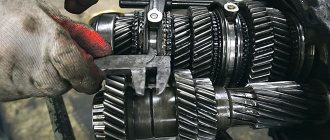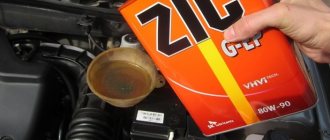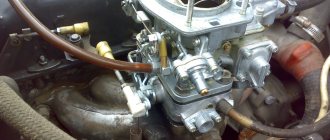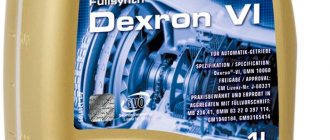GAZelle Next is a family of medium-duty vehicles produced since 2013. The model is the ideological successor to the classic GAZelle, which is still in production. Despite the fundamental external differences, the cars of the Next family have many technical components and assemblies from previous GAZelles.
The Next line is quite diverse: there are two-door vans and buses, as well as four-door vans, as well as a bus with 14 or 17 seats. Since 2022, a reinforced flatbed truck with a gross weight of 4600 kg has been produced, and in 2022, a 17-cc TsMF and a bus with a 22-seater interior were built on its basis. In 2021, sales of a new version with the VW EA189 diesel engine began.
When to change the oil?
GAZelle cars are operated in rather difficult conditions under high loads. Therefore, you need to pay attention to the operation of all units, especially the transmission.
Transmission oil, unlike motor oil, does not need to be changed every 10 thousand kilometers. Each car manufacturer sets a specific replacement interval. For Gazelles it is 75 thousand km. But car owners recommend reducing this interval to 60 thousand km.
First of all, this is due to the operating conditions of the car. If the car is used only in urban conditions, then the transmission oil will not “get tired” too quickly. But when traveling outside the city and in industrial areas, the driver should check the condition of the transmission fluid more often.
Reviews
Maxim, Petrozavodsk. I am a novice entrepreneur who needed a small, light-duty van adapted to Russian conditions. The choice fell on the GAZelle Next with a Cummins 2.8 engine, which seems to enliven a rather heavy and clumsy truck, which is especially important when transporting heavy loads. An economical and high-torque engine that only requires changing fuel, oil and filters.
Alexey, Kaliningrad. I have a GAZelle Next with an imported 2.8 liter diesel engine, which has long been in demand around the world. Simple and easy to maintain, although the cost of spare parts could be lower. The cabin is comfortable and clearly visible from all sides - the glass area of Next is one of the best in its class.
Oil level control
Checking the transmission fluid level in GAZelle cars should be done every 20 thousand kilometers. This must be done even if there are no visible leaks. If for some reason the oil level decreases, it must be added to the gearbox housing.
Before checking the oil level, you need to thoroughly clean the breather with the cap and the adjacent surface of the box housing. This is necessary so that when checking the level, dirt does not get into the gearbox. After this, you can unscrew the plug. Since the Gazelle box is not equipped with a hole with a dipstick, the level is checked along the lower edge of the filler hole.
Oil control is carried out as follows:
- Before checking, you need to warm up the gearbox; a trip of 10-15 km is enough for this.
- The car should be placed on a flat surface, as a slight horizontal tilt will not give an accurate result.
- The lubricant should drain from the crankcase walls to the bottom. At the same time, you need to clean the filler cap.
- Unscrew the plug and observe the hole. A thin stream of grease indicates an abnormal oil level. Then use a syringe to add fluid to the gearbox and check the level again
- If the oil stops leaking, the fluid level has returned to normal.
- Tighten the plug
You only need to add the oil that is already in the gearbox. For a while, you can use a liquid of a different brand, but with similar characteristics.
It is prohibited to operate GAZelle vehicles with a low oil level. This applies to all models. If the volume of fluid is insufficient, air pockets may form, due to which the amount of lubricant supplied to the gearbox bearings and gears is reduced.
What is needed for replacement?
To change the oil, you should purchase the necessary tools:
- three-liter container for collecting waste liquid;
- new gear oil;
- a large syringe with a tube from a dropper or a special oil syringe to fill the liquid;
- a small amount of clean rags to remove dirt and grease residue.
Just in case, you can purchase flushing material to clean the gearbox if necessary.
Oil selection
Let's look at how much oil is in a GAZelle box and which one is best to fill.
The manufacturer does not indicate the specific volume of transmission fluid in the vehicle's operating instructions. This is due to the fact that, depending on the modification, the amount of oil can be from 1.2 to 1.6 liters. Therefore, it is recommended to purchase 2 liters of liquid, and leave any remaining liquid for topping up.
The same goes for the brand of oil. The vehicle's operating instructions contain information only about the viscosity of the fluid. It should be 75W, but you can use 80W or 85W. When choosing oil, car owners give preference to Castrol, TOTAL, TNK, Mannol materials. Regarding the class, the plant recommends GL-4 fluids. You can also use GL-5 oils of similar viscosity. But they contain more sulfur and wear out the synchronizers somewhat faster.
Castrol Syntrax Longlife 75W-140
Fully synthetic fluid designed for differentials and final drives of passenger vehicles and commercial vehicles where API GL-5 oils are required.
The material provides excellent protection against wear and extreme pressure over a wide range of ambient temperatures under any load. The liquid increases the service life of units, reduces operating costs, and has excellent fluidity at low temperatures.
The oil has high oxidative and thermal stability, prevents scuffing when driving off and has an extended replacement interval.
TOTAL TRANSMISSION GEAR 8 75W-80
Mineral gear oil for manual transmissions. Designed for units that require the use of fluids with a viscosity of SAE 75W-80 and API class GL-4+ (GL-4/5). Recommended by PSA (Peugeot, Citroen) as an oil with an extended replacement interval (250 thousand km). Contains a special modifier required for manual transmissions of PSA cars.
The oil has increased anti-corrosion, anti-wear and extreme pressure properties, increased fluidity at low temperatures, facilitates cold starts and reduces fuel consumption. It reduces vehicle maintenance costs and is highly stable in operation.
TNK Trans Gipoid Super 75W-90
Semi-synthetic gear oil for cars and trucks. Also suitable for hypoid gears, and fully meets the requirements of domestic and foreign manufacturers of such units. Can be used in transmissions where API GL-5 class fluids are prescribed.
The oil has high mechanical, thermal and oxidative stability, effectively protects synchronizers and gears from wear and corrosion. It ensures trouble-free engine starting at sub-zero temperatures, increases the service life of transmission components, has good anti-foam properties, and is compatible with any structural seal materials.
MANNOL Extra Getriebeoel 75W-90
High quality synthetic gear oil. It is used in differentials, rear axles, steering mechanisms and other transmission components where GL-4/5 class oils are required. Thanks to its composition, it can be used in synchronized gearboxes and highly loaded gears.
The oil has high performance characteristics, reduces wear of mechanisms, prevents the formation of corrosion and deposits. It improves the performance of the gearbox, has high thermal stability and excellent friction properties.
Step-by-step instruction
The oil change is carried out only on a warmed-up gearbox, since only in this case can almost all the waste be drained.
Your further actions will look like this:
- the vehicle is installed on an overpass or inspection hole and is additionally secured with special stops;
- the drain plug is cleaned of existing dirt, and at the same time we clean the area near the filler plug;
- Using a 12mm hexagon, unscrew the drain plug, under which the prepared container should first be installed;
- It will take at least 30 minutes for the liquid to completely drain;
- if the waste contains a small amount of metal shavings or is too dark in color, the gearbox should be washed with pre-purchased flushing material;
- after this, the drain hole should be tightened and the filler plug should be unscrewed;
- using a syringe, fill the box with the required amount of lubricant corresponding to the modification of your Gazelle;
- after the liquid is filled in, screw the filler cap into place;
- To complete the process, you need to drive the car and then inspect the gearbox for lubricant leakage. If this exists, all deficiencies should be eliminated immediately.
9.8. Wheel and tire care
During the operation of the car, it is necessary to timely tighten the wheel nuts in order to avoid breaking the mounting holes, remove rust from the wheels and touch-up them. To ensure the longest tire life, follow these guidelines:
- Maintain the required tire pressure. The pressure is checked on cold tires before leaving. At stops along the way, you should inspect the tires and visually monitor their air pressure. Do not drive with low tire pressure, even for short distances. Do not reduce the pressure in heated tires by letting air out of them, since during driving an increase in pressure is inevitable due to the heating of the air in them;
- perform wheel balancing. At the factory, tire and wheel assemblies are dynamically balanced using weights mounted on both sides of the rim flanges. Checking and balancing wheels and tires should be done on a special stand. The permissible residual imbalance on each side of the wheel and tire must not exceed 40 g on the wheel rim for 4x2 vehicles (45 g for 4x4 vehicles). If it is not possible to perform dynamic wheel balancing, you can perform static balancing. In this case, balancing weights should be installed on the edge of the rim located closer to the mounting surface of the wheel disk;
- When returning from a trip and at stops, you should inspect the tires and remove foreign objects from them. The vehicle should be parked in a clean and dry place. Do not allow oil, gasoline, or oil-based paint to come into contact with the tires;
- When parking the car for more than 10 days, you should put it on stands to relieve the tires, or periodically move the car. Do not park your vehicle on flat tires;
- Tire rotation (Fig. 9.8) should be done as necessary. The basis for rearranging tires may be the need to obtain uniform wear on all tires, including the spare, as well as to ensure the correct selection of tires on the axles. Tires that have equal tread wear should be installed on the axles, with more reliable tires should be installed on the front axle of the vehicle.
The maximum degree of tire tread wear corresponds to a residual groove depth of 1.6 mm, which is determined by measurements or wear indicators. Wear indicators, 1.6 mm high in the form of solid strips of rubber, are located in the tread belts and are marked on the sidewalls of the tire with TWI icons.
Rice. 9.8. Tire rotation scheme
Step-by-step instructions for replacing the lubricant
Changing the oil in this vehicle yourself is not easy. Special procedures will need to be followed, but it is important to know how and in what order. So that readers can understand how this happens, I will give a step-by-step algorithm for general actions:
- Before changing the lubricant, you will need to check its level in the system. You need to clean the neck of the container from dirt and wipe the crankcase with a rag. All that remains is to unscrew the lid. It is necessary that the car is parked on level ground and wait until the oil drains into the crankcase.
- If, after unscrewing, the lubricant begins to flow in a trickle, then this is a signal that the oil is below the normal level.
- The lubricant will need to be replaced. To do this, you need a bucket or canister for working out, a syringe for adding lubricant, rags and new oil.
- The lubricant is drained through the drain hole, and then a new product can be poured into it. It is important to ensure that the normal level of the substance is achieved.
Nevertheless, it is recommended to entrust this procedure to experienced mechanics, especially if there is no place or time for the procedure.
Changing the Oil in the gearbox and gearbox - logbook GAZ Gazelle Next “TRUCK” 2016 on DRIVE2
Greetings to everyone who reads my entries! While I was at home, I did everything with the car to the maximum, and now I changed the oil in the axle and gearbox, exactly 2.5 liters entered the axle and was already leaking from the filler hole, and 1.8 liters was poured into the gearbox. A terrible black slurry drained from the bridge; you can see how many shavings are there on the plug; I changed the oil for the first time on the bridge. You can probably change the thousand to 20 tons earlier for the first time. for example, the best thing is that everything will have time to ride and sharpen and you can drain it. (advice for those who haven’t done this yet) but next time I think I’ll change it only at 100t.km The second canister was not useful since there was still some oil left from the last time, the rest will be in reserve.
I also replaced the stabilizer rubber bands, installed polyurethane, well, in principle, the old ones would still serve.
Moslo 2600 for 4 liters. Name: Semi-synthetic gear oil LIQUI MOLY Hypoid-Getriebeoil TDL 75W-90
Stabilized the rubber bands. 130r 1 piece
The bridge is sweating from the factory, how to deal with it? I also cleaned the breather, it was clogged.
Fill through the lever
Bridge plugs with shavings
Bridge plug shavings
A device for pouring oil into the bridge, you just have to wait a long time for it to run away, I took a thin hose, and it’s so convenient, you can also use it from a kettle with a thin spout, it’s also very convenient.
Price: 2,860 ₽ Mileage: 45,000 km
How often does a Gazelle gearbox need to be replaced?
In addition, how many liters of lubricant need to be poured into the Gazelle gearbox, you need to know how often this lubricant needs to be changed. Practice shows that there are a number of points during the operation of the machine that make it possible to determine the frequency of replacing the substance, namely:
- the more intensely the driver switches gears, the faster the lubricant used becomes clogged;
- Sooner or later, abrasive contact is created in the system, which means metal shavings begin to enter the liquid. Yes, it is very small, but over time there is a lot of this component, and it harms the operation of the gearbox;
- the lubricant poured into the system loses its viscosity, acquires a dark tint and ceases to perform all the functions assigned to it.
In order to notice the problem in a timely manner, it is important not to lose vigilance, but to regularly monitor the condition of the lubricant. If in appearance it no longer meets the standards or has been flooded for a very long time, you should think about replacing it.
To help the driver, each container of transmission fluid indicates its service life. Experimenting and using the composition for a longer time is highly not recommended.











